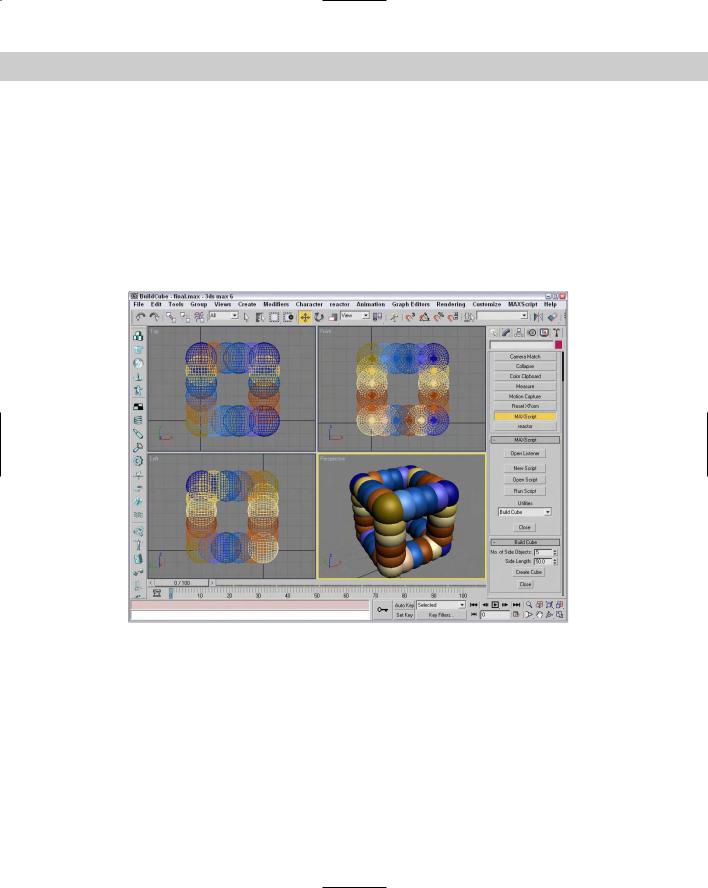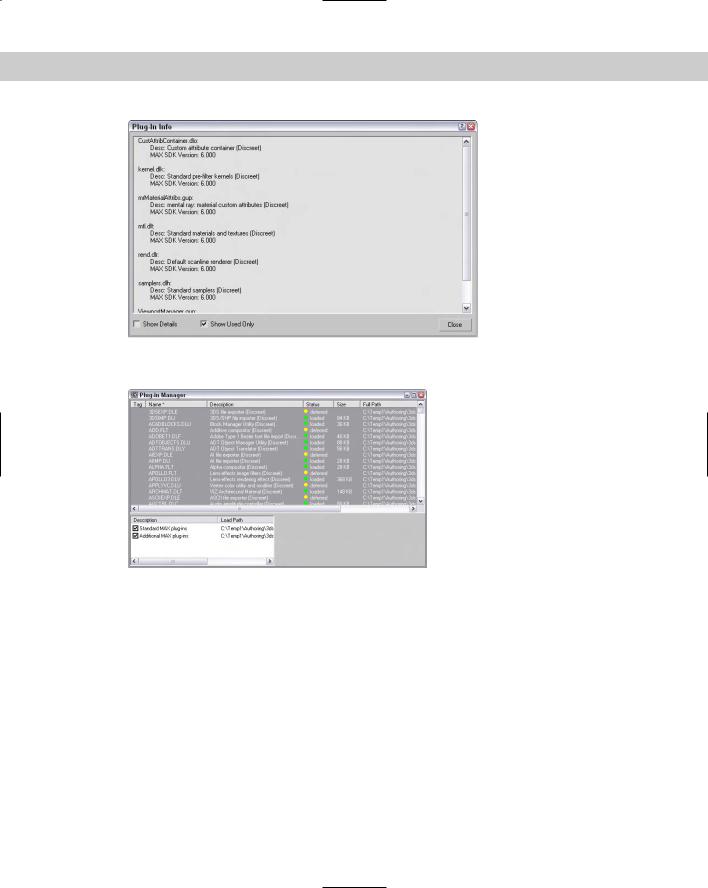
- •Preface
- •About This Book
- •Acknowledgments
- •Contents at a Glance
- •Contents
- •Relaxing at the Beach
- •Dressing the Scene
- •Animating Motion
- •Rendering the Final Animation
- •Summary
- •The Interface Elements
- •Using the Menus
- •Using the Toolbars
- •Using the Viewports
- •Using the Command Panel
- •Using the Lower Interface Bar Controls
- •Interacting with the Interface
- •Getting Help
- •Summary
- •Understanding 3D Space
- •Using the Viewport Navigation Controls
- •Configuring the Viewports
- •Working with Viewport Backgrounds
- •Summary
- •Working with Max Scene Files
- •Setting File Preferences
- •Importing and Exporting
- •Referencing External Objects
- •Using the File Utilities
- •Accessing File Information
- •Summary
- •Customizing Modify and Utility Panel Buttons
- •Working with Custom Interfaces
- •Configuring Paths
- •Selecting System Units
- •Setting Preferences
- •Summary
- •Creating Primitive Objects
- •Exploring the Primitive Object Types
- •Summary
- •Selecting Objects
- •Setting Object Properties
- •Hiding and Freezing Objects
- •Using Layers
- •Summary
- •Cloning Objects
- •Understanding Cloning Options
- •Mirroring Objects
- •Cloning over Time
- •Spacing Cloned Objects
- •Creating Arrays of Objects
- •Summary
- •Working with Groups
- •Building Assemblies
- •Building Links between Objects
- •Displaying Links and Hierarchies
- •Working with Linked Objects
- •Summary
- •Using the Schematic View Window
- •Working with Hierarchies
- •Setting Schematic View Preferences
- •Using List Views
- •Summary
- •Working with the Transformation Tools
- •Using Pivot Points
- •Using the Align Commands
- •Using Grids
- •Using Snap Options
- •Summary
- •Exploring the Modifier Stack
- •Exploring Modifier Types
- •Summary
- •Exploring the Modeling Types
- •Working with Subobjects
- •Modeling Helpers
- •Summary
- •Drawing in 2D
- •Editing Splines
- •Using Spline Modifiers
- •Summary
- •Creating Editable Mesh and Poly Objects
- •Editing Mesh Objects
- •Editing Poly Objects
- •Using Mesh Editing Modifiers
- •Summary
- •Introducing Patch Grids
- •Editing Patches
- •Using Modifiers on Patch Objects
- •Summary
- •Creating NURBS Curves and Surfaces
- •Editing NURBS
- •Working with NURBS
- •Summary
- •Morphing Objects
- •Creating Conform Objects
- •Creating a ShapeMerge Object
- •Creating a Terrain Object
- •Using the Mesher Object
- •Working with BlobMesh Objects
- •Creating a Scatter Object
- •Creating Connect Objects
- •Modeling with Boolean Objects
- •Creating a Loft Object
- •Summary
- •Understanding the Various Particle Systems
- •Creating a Particle System
- •Using the Spray and Snow Particle Systems
- •Using the Super Spray Particle System
- •Using the Blizzard Particle System
- •Using the PArray Particle System
- •Using the PCloud Particle System
- •Using Particle System Maps
- •Controlling Particles with Particle Flow
- •Summary
- •Understanding Material Properties
- •Working with the Material Editor
- •Using the Material/Map Browser
- •Using the Material/Map Navigator
- •Summary
- •Using the Standard Material
- •Using Shading Types
- •Accessing Other Parameters
- •Using External Tools
- •Summary
- •Using Compound Materials
- •Using Raytrace Materials
- •Using the Matte/Shadow Material
- •Using the DirectX 9 Shader
- •Applying Multiple Materials
- •Material Modifiers
- •Summary
- •Understanding Maps
- •Understanding Material Map Types
- •Using the Maps Rollout
- •Using the Map Path Utility
- •Using Map Instances
- •Summary
- •Mapping Modifiers
- •Using the Unwrap UVW modifier
- •Summary
- •Working with Cameras
- •Setting Camera Parameters
- •Summary
- •Using the Camera Tracker Utility
- •Summary
- •Using Multi-Pass Cameras
- •Creating Multi-Pass Camera Effects
- •Summary
- •Understanding the Basics of Lighting
- •Getting to Know the Light Types
- •Creating and Positioning Light Objects
- •Viewing a Scene from a Light
- •Altering Light Parameters
- •Working with Photometric Lights
- •Using the Sunlight and Daylight Systems
- •Using Volume Lights
- •Summary
- •Selecting Advanced Lighting
- •Using Local Advanced Lighting Settings
- •Tutorial: Excluding objects from light tracing
- •Summary
- •Understanding Radiosity
- •Using Local and Global Advanced Lighting Settings
- •Working with Advanced Lighting Materials
- •Using Lighting Analysis
- •Summary
- •Using the Time Controls
- •Working with Keys
- •Using the Track Bar
- •Viewing and Editing Key Values
- •Using the Motion Panel
- •Using Ghosting
- •Animating Objects
- •Working with Previews
- •Wiring Parameters
- •Animation Modifiers
- •Summary
- •Understanding Controller Types
- •Assigning Controllers
- •Setting Default Controllers
- •Examining the Various Controllers
- •Summary
- •Working with Expressions in Spinners
- •Understanding the Expression Controller Interface
- •Understanding Expression Elements
- •Using Expression Controllers
- •Summary
- •Learning the Track View Interface
- •Working with Keys
- •Editing Time
- •Editing Curves
- •Filtering Tracks
- •Working with Controllers
- •Synchronizing to a Sound Track
- •Summary
- •Understanding Your Character
- •Building Bodies
- •Summary
- •Building a Bones System
- •Using the Bone Tools
- •Using the Skin Modifier
- •Summary
- •Creating Characters
- •Working with Characters
- •Using Character Animation Techniques
- •Summary
- •Forward versus Inverse Kinematics
- •Creating an Inverse Kinematics System
- •Using the Various Inverse Kinematics Methods
- •Summary
- •Creating and Binding Space Warps
- •Understanding Space Warp Types
- •Combining Particle Systems with Space Warps
- •Summary
- •Understanding Dynamics
- •Using Dynamic Objects
- •Defining Dynamic Material Properties
- •Using Dynamic Space Warps
- •Using the Dynamics Utility
- •Using the Flex Modifier
- •Summary
- •Using reactor
- •Using reactor Collections
- •Creating reactor Objects
- •Calculating and Previewing a Simulation
- •Constraining Objects
- •reactor Troubleshooting
- •Summary
- •Understanding the Max Renderers
- •Previewing with ActiveShade
- •Render Parameters
- •Rendering Preferences
- •Creating VUE Files
- •Using the Rendered Frame Window
- •Using the RAM Player
- •Reviewing the Render Types
- •Using Command-Line Rendering
- •Creating Panoramic Images
- •Getting Printer Help
- •Creating an Environment
- •Summary
- •Creating Atmospheric Effects
- •Using the Fire Effect
- •Using the Fog Effect
- •Summary
- •Using Render Elements
- •Adding Render Effects
- •Creating Lens Effects
- •Using Other Render Effects
- •Summary
- •Using Raytrace Materials
- •Using a Raytrace Map
- •Enabling mental ray
- •Summary
- •Understanding Network Rendering
- •Network Requirements
- •Setting up a Network Rendering System
- •Starting the Network Rendering System
- •Configuring the Network Manager and Servers
- •Logging Errors
- •Using the Monitor
- •Setting up Batch Rendering
- •Summary
- •Compositing with Photoshop
- •Video Editing with Premiere
- •Video Compositing with After Effects
- •Introducing Combustion
- •Using Other Compositing Solutions
- •Summary
- •Completing Post-Production with the Video Post Interface
- •Working with Sequences
- •Adding and Editing Events
- •Working with Ranges
- •Working with Lens Effects Filters
- •Summary
- •What Is MAXScript?
- •MAXScript Tools
- •Setting MAXScript Preferences
- •Types of Scripts
- •Writing Your Own MAXScripts
- •Learning the Visual MAXScript Editor Interface
- •Laying Out a Rollout
- •Summary
- •Working with Plug-Ins
- •Locating Plug-Ins
- •Summary
- •Low-Res Modeling
- •Using Channels
- •Using Vertex Colors
- •Rendering to a Texture
- •Summary
- •Max and Architecture
- •Using AEC Objects
- •Using Architectural materials
- •Summary
- •Tutorial: Creating Icy Geometry with BlobMesh
- •Tutorial: Using Caustic Photons to Create a Disco Ball
- •Summary
- •mental ray Rendering System
- •Particle Flow
- •reactor 2.0
- •Schematic View
- •BlobMesh
- •Spline and Patch Features
- •Import and Export
- •Shell Modifier
- •Vertex Paint and Channel Info
- •Architectural Primitives and Materials
- •Minor Improvements
- •Choosing an Operating System
- •Hardware Requirements
- •Installing 3ds max 6
- •Authorizing the Software
- •Setting the Display Driver
- •Updating Max
- •Moving Max to Another Computer
- •Using Keyboard Shortcuts
- •Using the Hotkey Map
- •Main Interface Shortcuts
- •Dialog Box Shortcuts
- •Miscellaneous Shortcuts
- •System Requirements
- •Using the CDs with Windows
- •What’s on the CDs
- •Troubleshooting
- •Index

Chapter 48 Automating with MAXScript 1151
10.Open the Utilities panel, and click the MAXScript button. Then click the Run Script button, and select the BuildCube.ms file from the Chap 48 directory on the CD-ROM.
The utility installs and appears in the Utility drop-down list in the MAXScript rollout.
11.Select the BuildCube utility from the drop-down list in the MAXScript rollout, and scroll down the Command Panel to see the Build Cube rollout. Select the sphere object, and click the Create Cube button.
The script executes, and a cube of spheres is created.
Figure 48-18 shows the results of the BuildCube.ms script. You can use this script with any selected object.
Figure 48-18: The results of the BuildCube.ms script
Summary
This chapter gave you a brief introduction to MAXScript, 3ds max’s powerful, built-in scripting language. Besides describing the different types of scripts you can create, the chapter covered the following topics:
The basics of MAXScript
Using the MAXScript tools such as the MAXScript editor and Listener windows
Using the Macro Recorder to create scripts

1152 Part XII MAXScript and Plug-Ins
The different script types
The basics of writing your own scripts
The Visual MAXScript Editor interface
The features of each rollout element
How to create scripted utilities with custom rollouts
Now that you’re feeling more comfortable with scripts, we look at the pinnacle of added functionality — plug-ins.
|
|
|

Expanding Max with Third-Party Plug-Ins
Aplug-in is an external program that integrates seamlessly with the Max interface to provide additional functionality. Discreet
has adopted an architecture for Max that is open and enables all aspects of the program to be enhanced. Max ships with a Software Developer’s Kit (SDK) that enables users to generate their own plugins. Many companies currently produce plug-ins, and other users create and distribute freeware and shareware plug-ins.
Covering all the available plug-ins would be difficult, so this chapter covers a random sampling to give you an idea of the types of plug-ins that are available and their capabilities.
The entire architecture of Max is built around plug-ins, and many of the core components of Max are implemented as plug-ins. Max ships with a robust Software Developer Kit (SDK) that includes all the information you need to create your own plug-ins.
A key feature that allowed Max to become and remain so popular is that users can download and install plug-ins that extend Max’s power and functionality. Plug-ins allow Max to adapt to the needs of each user as well as keep up with new ideas.
Working with Plug-Ins
After you’ve located a plug-in that you would like to add to your system, you need to install the plug-in. Most commercial plug-ins come with an executable setup program that automates this for you, but others need to be installed manually, which isn’t difficult.
Note Plug-ins typically won’t work from one version of Max to another. If the plug-in is commercial, then the developers usually release an updated version of the plug-in for the new Max version.
As you begin to add plug-ins to Max, you may eventually want to see which plug-ins are installed and even disable certain plug-ins. Max includes tools to view installed plug-ins and to manage your current plug-ins.
49C H A P T E R
In This Chapter
Understanding plug-ins
Locating plug-ins
Installing, viewing, and managing plug-ins
Looking at plug-in examples

1154 Part XII MAXScript and Plug-Ins
Installing plug-ins
For commercial plug-ins that include an installation program, the installation process asks where the Max root directory is located. From this root directory, the plug-in program files are installed in the “plugins” directory, help files are installed in the “help” directory, and example scenes are installed in the “scenes” directory.
Plug-in program files typically have a .DLC, .DLR, .DLO, .DLU, .DLV, or .DLM extension, depending on the type of plug-in. When Max loads, it searches the plugins directory for these files and loads them along with the program files. You can manually install freeware plug-ins simply by copying the plug-in file into the plugins directory and restarting Max.
You can also place plug-ins in a different directory and load them from this directory. The Path Configuration dialog box is where you can specify additional plug-in paths.
Cross- |
Find out more about the Path Configuration dialog box in Chapter 4, “Customizing the Max |
Reference |
Interface and Setting Preferences.” |
|
Most commercial plug-ins require that the plug-in be authorized after installation. You must do this before you can use the plug-in, and you can usually do it via telephone, fax, or e-mail.
To remove a plug-in, use the uninstall feature that is part of the setup process, or delete the associated program files from the plugins directory.
Plug-ins can also create a help file that explains how to work with the plug-in. These help files are installed in the /help directory where Max is installed. To view these help files, open the Additional Help dialog box by choosing Help Additional Help.
Viewing installed plug-ins
To see all the currently installed plug-ins, choose File Summary Info to open the Summary Info dialog box and click the Plug-In Info button. This opens the Plug-In Info dialog box that lists all installed plug-ins with their details, as shown in Figure 49-1. As you can see, many plug-ins created by Discreet are installed with just the default installation.
Note |
Even if you haven’t installed any plug-ins, this dialog box lists many plug-ins. These are core |
|
functions in Max that are implemented as plug-ins. |
Managing plug-ins
You can manage which installed plug-ins are available using the Plug-in Manager dialog box, shown in Figure 49-2. Open this dialog box by choosing Customize Plug-in Manager.
Each column in the Plug-in Manager dialog box includes information about the plug-ins. The columns include Tag, Name, Description, Status, Size, and Full Path. You can sort the list of plug-ins alphabetically by column if you click on the column name.
Each unique directory that is specified within the Configure Paths dialog box appears in the bottom pane of the Plug-in Manager. Use the check boxes to remove all plug-ins from that directory from the list.

Chapter 49 Expanding Max with Third-Party Plug-Ins 1155
Figure 49-1: The Plug-In Info dialog box includes a list of all the currently loaded plug-ins, both internal and external.
Figure 49-2: Use the Plug-in Manager dialog box to disable plug-ins.
In the list of plug-ins, you select a specific plug-in by clicking it. You can select multiple plugins in the list using the Ctrl and Shift keys. A right-click pop-up menu of options lets you control the selected plug-ins. You can also tag (or mark) certain plug-ins using the Tag Selected option in the right-click pop-up menu. For tagged plug-ins, a white check mark appears in the left column.
You can also choose to load or defer selected or checked plug-ins using the right-click pop-up menu. Plug-ins with a status of loaded are currently loaded in memory and available; these plug-ins are identified with a green circle in the Status column. The deferred plug-ins are waiting in the wings and load when needed; these plug-ins are identified with a yellow circle in the Status column. Plug-ins that are marked Unloaded (with a red circle) are not in memory.

1156 Part XII MAXScript and Plug-Ins
Using the right-click pop-up menu, you can also select Load New Plug-in, which opens the Choose Plug-in File dialog box where you can select a plug-in file. The file is then accessed from this directory and loaded into the Plug-in Manager list.
Many types of plug-ins are used to add many different kinds of features. This section includes some tutorials that show some of the available plug-in capabilities.
Tutorial: Installing and using the AfterBurn Plug-in Demo
If you’d like to try out some plug-ins before purchasing them, pull out the Partners CD that comes with Max or visit the developers’ Web sites to download a demo copy of the plug-in.
Caution |
These demos are full-featured, but most of them are save-disabled, which prevents you from |
|
saving the file that includes the plug-in’s features. Look at the readme file as the plug-in is |
|
installed to see what has been disabled. |
To install a demo plug-in from the Partners CD, follow these steps:
1.Insert the Partners CD-ROM into your CD-ROM drive. A menu of options appears. Click the Discreet Certified Plug-Ins link. A page of certified plug-in demos appears, including AfterBurn, Absolute Character Tools, DreamScape, and others.
2.Click AfterBurn to select it and click the Install button. This launches the installation wizard. Follow the Installation Wizard’s instructions and press Next to complete each step. Click the Finish button when the installation is complete.
3.You need to restart Max before the plug-ins features become available. Select Start Program Files Discreet 3ds max 6 to restart Max.
4.You can learn to use the AfterBurn plug-in using the help files that were installed. Select Help Additional Help and double-click the AfterBurn 3 reference in the list that opens. This opens the Help files for the plug-in.
5.After reviewing the help files, select Create Helpers Atmospherics Sphere Gizmo and drag in the Top viewport to create a gizmo.
6.Most of the AfterBurn plug-in features are found in the Environment & Effects dialog box. Select Rendering Environment (keyboard shortcut, 8) and click the Add button in the Atmosphere rollout. In the Add Atmospheric Effect list, double-click on the AfterBurn Combustion Demo effect. This adds the AfterBurn Combustion effect along with the AfterBurn Renderer to the Effects list and makes several new rollouts appear.
7.In AfterBurn Combustion Parameters rollout, click the Pick Gizmos button and select the Sphere Gizmo icon in the Top viewport.
8.Select Rendering Render (F10) to open the Render Scene dialog box. Make sure the Atmospherics option is enabled and render the Perspective viewport to see the resulting AfterBurn flame effect.
Figure 49-3 shows the resulting fireball created using the AfterBurn demo plug-in.
